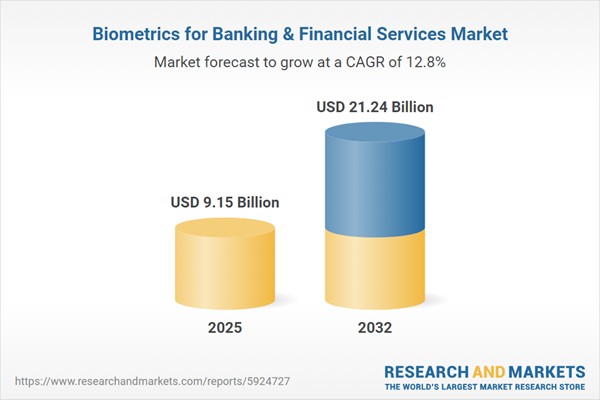Speak directly to the analyst to clarify any post sales queries you may have.
Biometric authentication is redefining the security paradigm in global banking and financial services. Senior leaders are leveraging resilient digital identity solutions to ensure compliance, mitigate risk, and support client trust as digital transactions and regulatory needs grow more complex.
Market Snapshot: Biometrics for Banking & Financial Services
The biometrics for banking and financial services market is experiencing significant growth, attributed to heightened digital threats, cross-border compliance pressures, and increasing adoption of digital client verification. The sector is projected to reach USD 21.24 billion by 2032, achieving a CAGR of 12.80% from 2024 to 2032. As financial institutions accelerate integration of advanced authentication systems, both mature and emerging markets prioritize the creation of standard, secure environments that safeguard sensitive data and foster seamless international banking, all while advancing regulatory convergence across geographies.
Scope & Segmentation of the Biometrics for Banking Market
- Operation Modes: ‘One to Many’ and ‘One to One’ authentication are adopted for verified access in remote and on-premise settings, supporting a wide array of institutional and customer scenarios.
- Component: Solutions encompass biometric hardware such as advanced sensors and readers, and software platforms including middleware and SDKs. Services for implementation, integration, and ongoing support ensure customized, compliant deployments for each organization.
- Technology: Key methods include facial, fingerprint, iris, voice, signature, and vein recognition systems. Banks and fintechs often layer multiple biometric technologies to address complex security and regulatory requirements effectively.
- Deployment: Options range from on-premises and private cloud to public cloud and hybrid models, enabling organizations to match infrastructure to operational priorities and jurisdictional obligations.
- Application: Biometric solutions support secure access at ATMs, bank branches, service centers, online portals, and mobile apps, ensuring comprehensive, accessible protection across client touchpoints.
- Regions: Implementation is rapidly advancing in the Americas, Europe, Middle East and Africa, and Asia-Pacific. In Asia-Pacific, domestic regulatory conditions and adoption rates vary by country, with markets such as China, India, Japan, and Australia each progressing under unique factors.
- Key Companies: Sector leaders including IDEMIA SAS, Thales Group, NEC Corporation, Fujitsu Limited, Daon Inc., Aware Inc., Mitek Systems Inc., Suprema Inc., Fingerprint Cards AB, and NXP Semiconductors N.V. deliver comprehensive global solutions tailored to evolving sector requirements.
Key Takeaways for Senior Decision-Makers
- Multi-factor authentication strengthens operational resilience, enabling institutions to quickly respond to evolving risks and updates in compliance standards.
- Digital client onboarding is streamlined, minimizing friction while enhancing risk controls and fortifying regulatory adherence.
- Modular software ensures easy integration of biometric solutions with existing banking infrastructure, supporting swift adaptation as requirements shift.
- Prioritizing mobile-first authentication approaches expands secure remote service, offering broader access and supporting growth in new demographics and geographies.
- Robust API frameworks maximize interoperability, ensuring new biometric systems connect effectively with both legacy and open banking environments for ongoing innovation.
- Institutions benefit from flexible biometric infrastructures which position them to adapt to fluctuating regulatory and operational landscapes with greater confidence.
Tariff Impact: United States Tariff Policy in 2025
Upcoming changes to United States tariff policy may influence costs for biometric hardware across the financial industry. In anticipation, organizations are strengthening domestic procurement channels and supplier networks to reduce exposure to global volatility. Increased adoption of modular and cloud-based software further enhances flexibility, minimizing disruptions linked to external economic or regulatory changes. Sustained collaboration between technology partners and financial institutions is critical to maintaining stable operations as regulation evolves.
Methodology & Data Sources
This analysis draws on primary research, comprehensive regulatory review, corroborated industry reports, and insights from financial technology experts. The multi-source approach delivers a nuanced assessment of adoption dynamics, technical advancements, and sector-specific challenges.
Why This Report Matters
- Provides senior leaders with actionable guidance for aligning biometric strategies with digital transformation, risk management, and procurement initiatives.
- Facilitates the secure deployment of digital identity systems and fosters stronger client relationships in increasingly digital banking environments.
- Equips decision-makers with a framework to navigate regulatory shifts and adopt technology without compromising operational standards or client expectations.
Conclusion
Biometric authentication is propelling the financial sector toward a future of heightened security and regulatory clarity. Proactive, strategic deployment equips organizations to protect client trust and stay ahead of evolving industry demands.
Additional Product Information:
- Purchase of this report includes 1 year online access with quarterly updates.
- This report can be updated on request. Please contact our Customer Experience team using the Ask a Question widget on our website.
Table of Contents
3. Executive Summary
4. Market Overview
7. Cumulative Impact of Artificial Intelligence 2025
Companies Mentioned
The companies profiled in this Biometrics for Banking & Financial Services market report include:- IDEMIA SAS
- Thales Group
- NEC Corporation
- Fujitsu Limited
- Daon, Inc.
- Aware, Inc.
- Mitek Systems, Inc.
- Suprema Inc.
- Fingerprint Cards AB
- NXP Semiconductors N.V.
Table Information
| Report Attribute | Details |
|---|---|
| No. of Pages | 192 |
| Published | October 2025 |
| Forecast Period | 2025 - 2032 |
| Estimated Market Value ( USD | $ 9.15 Billion |
| Forecasted Market Value ( USD | $ 21.24 Billion |
| Compound Annual Growth Rate | 12.8% |
| Regions Covered | Global |
| No. of Companies Mentioned | 11 |









